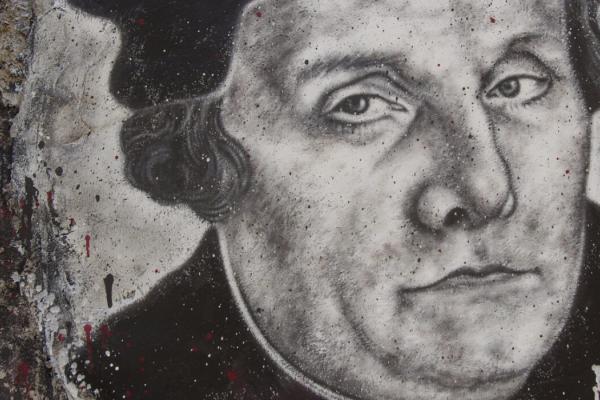ON Oct. 31, 1517, an intense 33-year-old Catholic monk with deep-set eyes and a prominent chin nailed an announcement of proposed points—95 theses—for a university discussion to the door of the Castle Church in Wittenberg, Germany. Martin Luther, a well-respected University of Wittenberg professor and administrator, was attacking the sale of indulgences by the Roman Catholic Church, in which the well-to-do “bought” their relatives out of purgatory by investing in “good works” for the church. Poorer people followed suit with a few coins.
Luther was far from the only critic of indulgences, but his action got attention. Intelligent and charismatic, he was not easily dismissed. He sparked the Protestant Reformation, marking its 500th anniversary this year, at that church door. This review touches on three Luther biographies: chiefly the new Martin Luther: Renegade and Prophet, by Lyndal Roper, the first woman named Regius Professor of History at Oxford University, but also Brand Luther, by Andrew Pettegree, and Martin Luther: Visionary Reformer, by Scott H. Hendrix.
Luther’s fame grew after he refused to recant his criticisms of the Catholic Church at the 1521 Diet of Worms, in front of Charles V, the Holy Roman Emperor. Luther was declared a heretic and excommunicated. This incident, Roper writes, “probably did more to win people over to the Reformation and shape their hopes and expectations than did his theology.”
After leaving Worms, Luther was “kidnapped” by friendly forces and taken to Wartburg Castle, thwarting any immediate attempts by the church to harm him. In his 10 months there, Luther translated the New Testament into German. Then, back in Wittenberg, he and his colleague Lucas Cranach embarked on a wholesale revamping of the printing industry. The printing press, invented less than a century earlier, had been used mainly for long, ponderous religious texts that few bought. Luther, with his vigorous, direct writing style and vernacular German translations, aimed an avalanche of books, hymnals, pamphlets, broadsheets, Bibles, and sermons at the general public. This went hand-in-hand with his idea that the lay person did not need an intermediary to interpret the Bible.
Pettegree’s original research into this formerly unexplored area of Luther’s life is exhaustive and offers a new dimension to Luther studies.
Luther continued a wrenching theological metamorphosis through his reading of scripture and analysis of Catholic Church practices. He questioned the pope’s divine authority, the attribution of intercessory power to Mary and saints, the right of priests to grant forgiveness through the sacrament of confession, and the insistence that priests, monks, and nuns remain celibate.
Despite courting and receiving popular support from regular people, Luther was blindsided by the Peasant War, which broke out in autumn 1524. The peasant rebels invoked Luther’s anti-clericalism as their reason for revolt; they desecrated and looted churches, attacked priests, and murdered nobles. Eventually the peasants were “put down.” Hendrix estimates that the conflict “claimed perhaps 80,000 lives, about twice the estimated number that died in the American Revolution.” Luther was apoplectic. He had never advocated violence. He declared the peasants to be “mad dogs” who did nothing “but pure devil’s work,” and he sided with the princes, which has haunted his legacy through the centuries.
Luther’s insistence that celibacy for monastics was not scriptural caused a veritable sexual rebellion in the 1520s. Nuns ran away from their convents, influenced by Luther’s view. As they arrived in Wittenberg with little money and no shelter, he became an impromptu marriage broker. One strong-willed, intelligent former nun named Katharina von Bora became his wife. Together they had six children, hosted many families, students, and theologians in Luther’s former monastery, and by all accounts had a very successful marriage, despite ferocious attacks from detractors.
Luther was not “modern,” warns Roper, and “unless we appreciate his thought in its own, unfamiliar and often uncomfortable terms, we will not see what it might have to offer to us today.”
Lyndal Roper is a brilliant biographer and conduit for Luther, in the manner that biographer Robert Caro is for Lyndon Johnson, another larger-than-life man with profound successes and long periods of deep vindictiveness, cruelty, and score-settling. Roper drills deep into Luther’s psyche, describing the “visceral” anti-Semitism that came to the forefront in the final years of his life. She points out, in a fascinating insight, that “despite his hatred, there were several aspects of Luther’s theology that were akin to Judaism, and it is perhaps this proximity that triggered the violence of his assault: He had comparatively little to say about an afterlife; his religiosity put the importance of scripture and exegesis of the Hebrew and Greek texts center stage ... and his remarkably positive attitude toward the body placed him very close to the Jewish emphasis on fertility rather than virginity.”
These similarities perhaps gave Luther even more reason to fear for his life. The specter of being burned alive, disemboweled, tortured, or paraded through a city naked had been with him for close to 30 years. Many Protestants had suffered one or all of these fates. In his later life Luther was often miserable, and entangled in personal battles over the Reformation’s direction.
Roper details Luther’s many failings at length, but in the end, she generously sums up: “Luther’s extraordinary openness, his honest willingness to put everything on the line, and his capacity to accept grace as a gift he did not merit, are his most attractive characteristics.”

Got something to say about what you're reading? We value your feedback!
